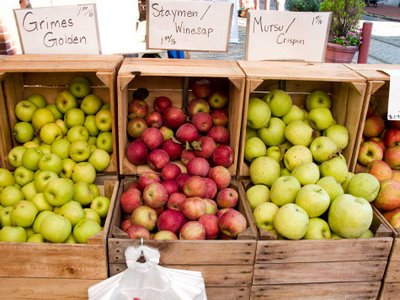Sunday, October 12, 2008
Winesaps Arrive!

With my store of Cox Orange Pippins rapidly dwindling it's time to resupply. And, just in time, the winesaps are here. These Stayman Winesaps were offered at the Headhouse Square market today by the Wenk family's Three Springs Fruit Farm. Over at Beechwood farms they offered a variety called Turley Winesap. A quick Googling divulged that it was developed in the late 19th century in Indiana. It's apparently not quite as fine a fresh-eating (dessert) apple as the Stayman, but is very good for baked applications. It was particularly important in the early 20th century because of its storage quality and ability to be shipped by rail with little delerious effect.
Over at North Star I picked up a couple each of Golden Russet and Sugar Snap varieties.The former is another fav: a crisp, sweet, medium-sized apple that's a good keeper. So what if it's not red! I haven't tasted the Sugar Snap yet, which has a nice red inflected skin. North Star's website says it's a sweet-tart apple derived from the Empire.
What is it, precisely that separates a common apple from an antique/heirloom variety? That's a discussion I had with Sarah Cain, co-manager of the Fair Food Farmstand yesterday when I noted the sign for the Jonamac's called them heirlooms. Just by its name, I expressed my doubt that the apple qualified, because it's an intentional Jonathan-MacIntosh cross. Sarah contends that even hybrids developed by orchardists qualify fror the "heirloom" nominclature so long as they are 50 years old.
Even on that basis, however, it's hard to justify calling this cross an heirloom or antique. Although the New York State Agircultural Station in Geneva began experimenting with Jonathan-MacIntosh crosses in 1944, a final cross wasn't introduced to the commercial market until 1972, though the strain was largely developed, bred and tested since the late 1950s.
Although I've yet to fine a clear definition of what makes an an apple an "heirloom" or an "antique," my readings suggest that to most people, they mean a variety of apple that was developed introduced prior to the mass shipping by rail of apples in the early 20th century. Apples like the Jonamac, which were developed by government-funded entities after World War II, clearly don't qualify.
An excellent account of the search for heirloom apples under this definition can be found in the November 2002 issue of Smithsonian magazine.
Labels: apples, farmers markets, headhouse square, winesap
 Robert's Market Report
Robert's Market Report
